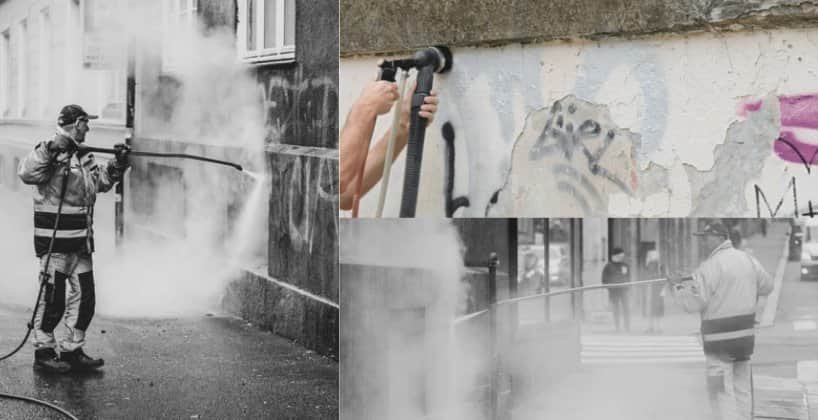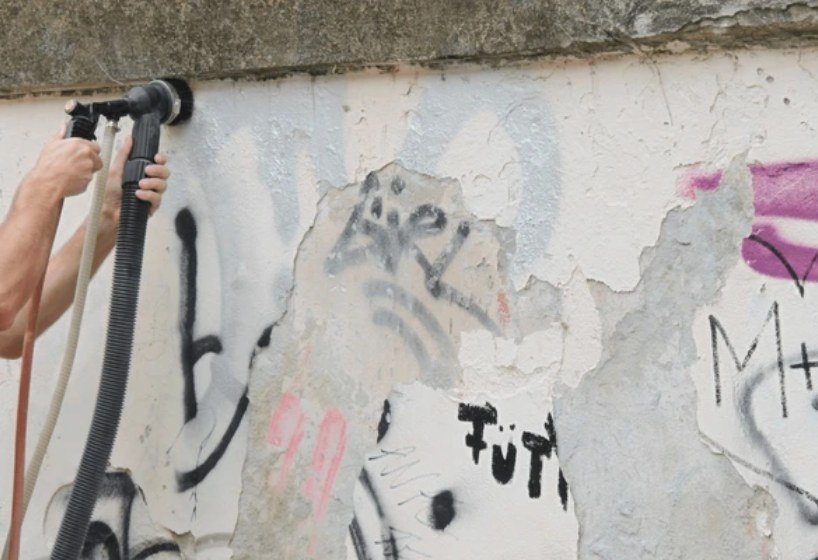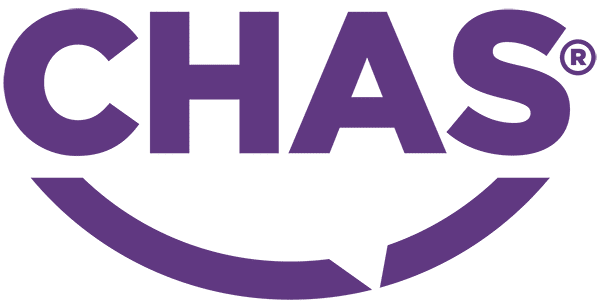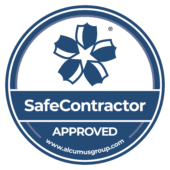There's no denying that graffiti and spray paint can really diminish the appearance of a building. Regardless of whether it is your home or your business, having graffiti paint all over your property can be frustrating... So how do you get rid of it? Can you get rid of it yourself? Is graffiti removal easy? Or is it worth our Cleethorpes graffiti removal services?
Here's everything you need to know about how to remove graffiti and see if the EMS Powerwash Cleethorpes team is the right company for you!
No hassle, no obligation—just a fair price for top-quality cleaning.

There are a number of factors that will impact both how easy it is to remove graffiti and which methods you are permitted to try. These must be considered before you begin graffiti removal, and can make it difficult to determine how best to remove graffiti.
If you're ever unsure what steps to take in your graffiti cleaning process, contact the EMS Powerwash Cleethorpes team for expert graffiti removal and graffiti prevention advice and services.
Not every graffiti artist will use the same spray paint to tag or decorate your home. In fact, not every vandal will use paint! The most common tools used for graffiti are spray paint, markers and bitumen spray. The composition of the different types of graffiti paint and tools out there differs hugely from one brand to another, each including different levels of oils, solvents and other ingredients.
Typically, it is fairly easy to determine which of the main three the unwanted graffiti has been done with. Spray paint will leave thick lines that get thinner further out, and usually will be used in large, sweeping strokes. Marker pens are much more even and thin. Bitumen will usually be sticky on your brick walls and surfaces.
Quite often, we don't notice graffiti that soon after the graffiti attack unless it is huge or on the front wall of the property. This hinders the graffiti removal process, as it is always easier to remove graffiti promptly after it has been applied. That's not to say efficient removal of graffiti is impossible if it is caught later, though. You will just have to put a bit more effort into the removal process, and you might find that more graffiti artists have added to the mess, as often one bit of graffiti attracts other artists.
The base that the graffiti is tagged on plays a huge part in how easy removing graffiti is. Graffiti can be found on everything from houses to underpasses. What has been painted on will impact the graffiti-cleaning process by determining how far the paint has seeped into the substrate. In porous surfaces like brick, for example, the paint may have gone further in than on a sheet of metal like a road sign. We use different methods for different surfaces for eg DOFF Cleaning services would be used for a delicate historic building or TORC cleaning services for extra special care to not disturb the original surface.
You might find that there are graffiti removal requirements which dictate what cleaning products you can use when it comes to cleaning graffiti. This is usually only the case on sensitive surfaces like historical buildings or listed buildings. The regulations enforced by your local authority will usually ban any graffiti removal products that contain harsh chemicals.
At EMS Powerwash, we offer expert cleaning services for homes and businesses across the East Midlands. Our team uses the best tools and techniques to make your property look brand new. No matter the job, we deliver reliable, high-quality results every time.
Once you've established the age, substance used, surface material and whether or not you need to watch which products you use, you can get to work graffiti cleaning.
It is always advisable to try and remove as much of the graffiti as possible manually. Avoiding using graffiti removal chemicals is better for the surfaces beneath and is more environmentally friendly. However, once you've removed as much as you can in this way, you can try other techniques.
You should then test your chosen graffiti removal methods on a small section of the graffiti. This will tell you whether or not the graffiti removal product works, and whether it causes any damage to the wall beneath.

Graffiti removal products do exist, and sometimes they can work well to get graffiti off of your walls or whatever other surfaces you find it on. However, most of the time, it is more efficient and safer to simply hire graffiti removers. With expert knowledge and the right equipment, experts like EMS Powerwash can quickly remove graffiti from porous and non-porous surfaces. Even on sensitive surfaces like natural stone, experts can remove graffiti without causing damage using the following techniques:
Using a pressure washer to remove graffiti from the wall is a very common technique. By using hot water alongside the high pressure it makes the chemical graffiti removers work quickly and effectively. The water is typically heated to between 60 and 80 degrees in order to best encourage the work of the chemical products.
When more care is needed, abrasive particle graffiti removal is used. Sometimes called eco blasting, this technique uses compressed air and an abrasive. It fires both at the walls or other surfaces very specifically. By doing so, it wears off the graffiti very gently. This technique works well on natural stone and brick, but cannot be used on metal, glass or concrete.
For really sensitive substrates, dry ice blasting is ideal. It is incredibly gentle, uses no chemicals and there is no wastewater or residue left after the process. It involves blasting dry ice pellets made of frozen CO2. These hit the surface at incredibly high speeds, causing the graffiti to become brittle. As a result, it starts to crack, allowing more pellets in. These pellets turn into CO2 gas and blast the paint particles off.
No hassle, no obligation—just a fair price for top-quality cleaning.

Graffiti removal is one thing, but graffiti prevention is also possible and can work just as well as graffiti removal products. Some graffiti prevention techniques include:
Permanent anti-graffiti coatings are available. These form films on surfaces that protect from solvents and can last up to 10 years. If graffiti is sprayed onto the surface, it can be removed with typical cleaning products and a wet cloth. These films also protect your walls and surfaces from UV light as an added consequence!
These are reapplied after graffiti removal, and essentially a layer of these coatings is lost each time graffiti occurs, but they protect the wall beneath.
There are also temporary coatings, which are completely lost each time graffiti occurs. However, they make the graffiti removal process much easier. When graffiti occurs, this type of anti-graffiti coating can be pressure washed. At which point, it and the graffiti are removed.
Graffiti can be removed from a wide range of surfaces, including brick, concrete, glass, metal, wood, and painted walls. Each surface requires a specific method to ensure effective and safe removal.
The time it takes to remove graffiti depends on the size, complexity, and surface type. Most graffiti removal jobs can be completed within a few hours, but larger or more intricate jobs may take longer.
Yes, graffiti removal is generally safe for all types of surfaces when the appropriate methods and products are used. We carefully select the best approach to avoid any damage to the underlying material.
Graffiti can be effectively removed from brick and concrete walls using specialised techniques such as high-pressure washing and environmentally friendly chemicals designed to penetrate and lift the paint.
The cost of graffiti removal varies based on the size, location, and type of surface. We offer free quotes to assess your specific needs and provide an accurate estimate.
Yes, we offer emergency graffiti removal services to ensure that unsightly graffiti is removed as quickly as possible, helping to maintain the appearance of your property.




